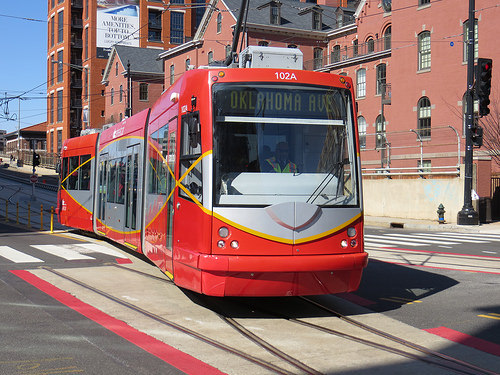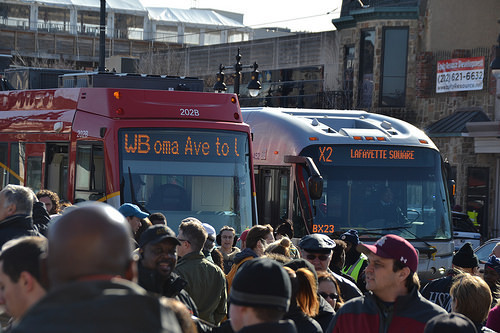Now that it’s open, 7 takeaways from the H Street streetcar
DC’s H Street streetcar has been open two and a half months. With two extensions on the horizon, now is a good time to look back at what’s worked and what hasn’t. Here are seven takeaways from the streetcar’s first season running.
1. Dedicated lanes matter for reasons beyond congestion
Streetcars on H Street are too slow. Not nearly as slow as walking, but too slow nonetheless. But H Street isn’t a particularly congested road compared to many in the region. Were it only for congestion, the streetcar should be faster than it is.
Parking is a big part of the problem. Streetcars are rarely seriously delayed due to actual lawbreaking double parkers, but have to slow to a crawl frequently for drivers legally pulling into or out of parking spaces.
Even when every car is parked correctly within its space and nobody seems to be coming or going, there’s so little room between tracks and the parking lane that streetcar drivers have to poke along, for fear of driving into an opening door or for scraping a slightly wayward mirror. If the tracks were better separated from the parking, streetcars could move faster.
On Benning Road where the streetcar runs in the middle rather than along the outer curb, parking isn’t a problem. There’s still friction from turning cars, but it’s not as bad.
2. Traffic signals need special attention
The biggest cause of delay on almost every streetcar trip I take is the 3rd Street traffic light. That’s where the streetcar crosses over traffic to get from the curbside along H Street to a dedicated lane in the middle of Hopscotch Bridge.
Getting into that dedicated lane takes forever. The streetcar can’t simply go with the green light because it’s crossing over traffic. It needs a dedicated signal phase. But because of how the signals are timed, waiting for that phase can take forever.
DDOT is looking at changes to that light to help speed streetcars through. That’s great. But signal priority for streetcars where they need it should be the rule, not the exception.
3. The streetcars are legitimately more comfortable than buses
The streetcars really are are comfortable, smooth, and quiet. Rumbling over broken asphalt in a crowded diesel bus is a loud, uncomfortable prospect. Not only are the streetcars noticeably smoother and quieter, but their spacious interiors rarely feel cramped, even when there are a lot of riders.
That matters. Not as much as basic operations, but it does matter. It draws riders and it helps make transit a nicer place to spend time.
4. The streetcars bunch way less than the X2
It could just be because the line is short, or maybe it’s because DDOT does a fantastic job with headway scheduling. It could also be that although the streetcar is slow, it’s fairly predictable.
Whatever the reason, I have yet to see streetcars bunched closely together.
5. Streetcar stops and bus stops would be better together
With both buses and streetcars on H Street, many riders would theoretically be happy to take whichever comes first. But streetcars and buses have different stops, usually a block apart. Depending on the location, riders sometimes have to commit to a stop before knowing which mode will arrive first.
Meanwhile, since bus stops and streetcar stops are staggered, buses and streetcars get in each others’ way all the time, while one is at a stop and the other moving. Buses can go around, but obviously streetcars can’t.
If they shared stops, long enough for both a bus and a streetcar to pull in at the same time, there’d be fewer delays and riders would have more freedom to choose their ride.
6. It’s nice to have a stop on Hopscotch Bridge
The connection from the streetcar’s Hopscotch Bridge stop to Union Station is hardly wonderful. But it is present, which is more than can be said for the X2. It makes connecting to longer distance transit easier on the streetcar.
7. We need more trams
15 minutes headways aren’t good enough, given the short length of the line, the slowness of the streetcars, and the frequency of the X2. Unfortunately, DDOT needs more railcars before they can increase the frequency, and getting those is not a quick process.
DDOT could add Sunday service, though. More riders use the streetcar on Saturdays than any other day. Meanwhile, the X2 runs least often on Sundays. There’s clearly a niche for weekend streetcar.
Given the vehicle limitations, adding Sunday service might require cutting back some other day, either not running at all one weekday, or running for fewer hours on weeknights. It’s probably worth it to try and see how things go.
What would you add?
Are you a regular streetcar rider? What would you add? What works, and what doesn’t?
Read more from today’s streetcar mega-feature:
- Now that it’s open, 7 takeaways from the H Street streetcar
- DC’s streetcar may go to Georgetown with dedicated lanes
- West of Union Station, no overhead streetcar wires
- A loop ramp under K Street and a pedestrian walkway
- Before going to Georgetown, the streetcar will go east to Benning Road




